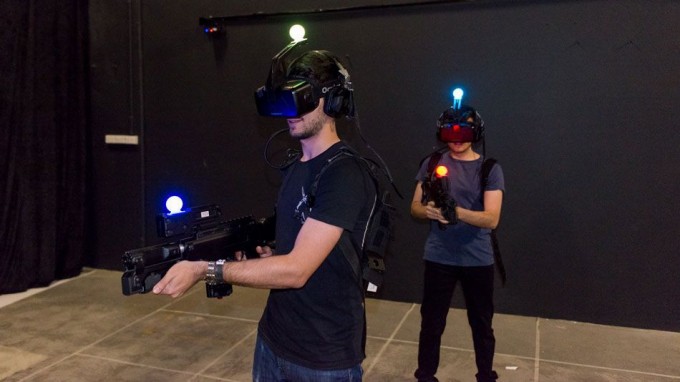
The gaming industry has experienced a remarkable evolution with the emergence of virtual reality (VR) and augmented reality (AR) technologies. These cutting-edge advancements have revolutionized our gaming experiences, blurring the lines between the virtual and real worlds. The intersection of gaming and VR/AR has unlocked unprecedented levels of immersion, interactivity, and realism for players. Whether venturing into virtual realms or augmenting the real world with digital overlays, this convergence has sparked a renaissance in gaming, merging the digital and physical realms inextricably. As you explore this captivating realm, you can even play Dancing Drums Explosion, unraveling the transformative experiences, possibilities, and challenges within this innovative frontier.
Exploring the Benefits of Utilizing Virtual Reality/Augmented Reality

Utilizing virtual reality (VR) and augmented reality (AR) in the gaming industry brings forth many benefits that enhance the gaming experience for players. One of the key advantages is the unprecedented level of immersion these technologies offer, transporting players into vivid and lifelike virtual worlds. By donning a VR headset or utilizing AR overlays, gamers can interact with their surroundings in ways never before imagined, fostering a deeply engaging and sensory-rich experience. Furthermore, VR/AR technologies facilitate a higher degree of interactivity, allowing players to manipulate and shape the game environment with their gestures and movements.
This heightened sense of agency and control adds a new layer of depth to the gameplay, encouraging exploration and experimentation. Additionally, the integration of VR/AR can promote social connectivity by enabling players to engage in multiplayer experiences and collaborative gameplay, even if they are physically apart. These advancements not only revolutionize the way we play games but also pave the way for innovative storytelling techniques and the creation of immersive narratives that blur the boundaries between fiction and reality.
How to Set Up Your Own VR/AR System at Home
Setting up your virtual reality (VR) or augmented reality (AR) system at home can be an exciting way to enjoy your gaming experience. To get started, you’ll need a few essential components. First, acquire a VR headset or AR glasses that are compatible with your device. Next, ensure you have a powerful computer or gaming console with sufficient processing capabilities and graphics performance. Set up sensors or cameras around your play area to precisely track your movements. Follow the manufacturer’s instructions to install the necessary software and drivers for your VR/AR system. Finally, create a comfortable and spacious environment for uninterrupted gameplay. With careful setup and preparation, you can embark on thrilling virtual adventures and explore the wonders of VR/AR right from the comfort of your own home.
Current and Upcoming Trends of VR/AR in Gaming

The realm of virtual reality (VR) and augmented reality (AR) in gaming is constantly evolving, with current and upcoming trends shaping the future of immersive gaming experiences. One prominent trend is the increasing focus on standalone VR headsets, which offer untethered freedom of movement and eliminate the need for external sensors or a PC/console connection.
Another exciting development is the integration of haptic feedback technology, enabling players to feel physical sensations within the virtual world, enhancing realism and immersion. Additionally, the rise of social VR platforms fosters multiplayer interactions and shared experiences, bringing players together in virtual spaces. Looking ahead, advancements in 5G connectivity, hand tracking, and AI are expected to further elevate the possibilities of VR/AR gaming, unlocking even more captivating and transformative experiences for players worldwide.
The Different Types of Games for Players Using VR/AR Technology

The advent of virtual reality (VR) and augmented reality (AR) technology has given rise to a diverse range of games that offer unique and immersive experiences. Here are some worth exploring:
- Exploration-based adventure games: Players traverse stunning virtual landscapes, interact with objects, and uncover hidden secrets.
- First-person shooter: Players can physically aim, dodge, and engage in intense combat scenarios.
- Puzzle-solving games: Players must manipulate and interact with objects in the virtual environment to progress.
- Simulation games such as flight or driving simulators offer incredibly realistic experiences through VR/AR.
The endless possibilities make VR/AR technology a gateway to many exciting and diverse gaming experiences.
Exploring Potential Growth Areas for the Future of VR/AR in Gaming

The future of virtual reality (VR) and augmented reality (AR) holds immense growth potential, with several key areas poised to shape the landscape. One growth area lies in eSports, where competitive gaming reaches new heights by immersing players and spectators in virtual arenas. Another promising avenue is the potential for integration into mobile devices, wearable tech, and smart glasses. Additionally, the development of advanced haptic feedback systems will enhance the sensory experience, allowing players to feel textures, impacts, and vibrations within the virtual world.
Furthermore, the intersection of VR/AR with artificial intelligence (AI) holds immense promise, enabling more intelligent and dynamic interactions with virtual characters and environments. As technology advances, these growth areas are set to revolutionize the gaming industry, offering unprecedented levels of immersion, interactivity, and realism.
The Bottom Line
Virtual reality and augmented reality have the potential to revolutionize the gaming industry. By creating immersive worlds that players can explore, they open up a new level of realism that will keep gamers coming back. With the right setup and an understanding of existing and upcoming trends, you can maximize the gaming abilities these technologies provide in combination with other hardware.
Furthermore, when considering potential growth areas for the future of VR/AR in gaming, it is clear that there is immense promise in social and educational uses as well as potential collaboration across various industries. Ultimately, VR and AR possess the possibility to offer an entirely new way to interact with video games not just as individuals but as communities themselves.




